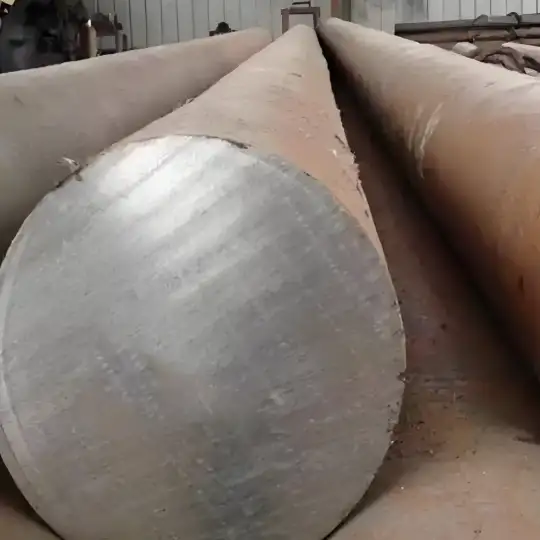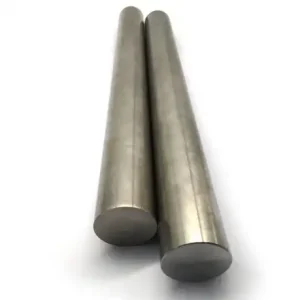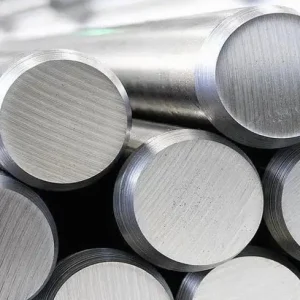Nitralloy 135 (often supplied as Nitriding 135 or Nitralloy 135M, UNS K24065) is a chrome-moly low-alloy steel intentionally formulated for nitriding to produce a very hard, wear-resistant surface while retaining a tough ductile core; it is commonly used for gears, cams, shafts and other heavily loaded components needing superior surface life with minimal distortion. Compared with AISI 4140 it contains deliberate aluminum and controlled alloying to improve nitride formation, so it behaves like a nitriding-optimized variant of 4140 rather than a direct replacement for through-hardened steels.
What is Nitralloy 135?
Nitralloy 135 is a nitriding steel grade engineered to develop an extremely hard case by introducing nitrogen into the surface (via gas, salt bath or plasma nitriding), while keeping a strong, ductile core. The “135” family has been used in aerospace and industrial components where dimensional stability and fatigue life after case hardening are crucial. The modified grades (135M, vac-arc remelted variants) provide superior cleanliness and consistent nitriding response for demanding parts.
Typical chemical composition (nominal / typical)
Below is a concise, industry-accepted composition summary used for procurement, quoting and material data sheets. Values are typical limits used by common datasheets for Nitralloy 135M; specific mill certificates should be used for production control.
| Element | Typical (wt.%) — Nitralloy 135 / 135M |
|---|---|
| Carbon (C) | 0.35 – 0.45 (nominal ~0.40) |
| Manganese (Mn) | 0.40 – 0.80 (nominal ~0.60) |
| Silicon (Si) | 0.20 – 0.40 (nominal ~0.30) |
| Chromium (Cr) | 1.20 – 1.80 (nominal ~1.60) |
| Molybdenum (Mo) | 0.25 – 0.45 (nominal ~0.35) |
| Aluminum (Al) | ~1.0 – 1.4 (critical for nitriding behavior) |
| Phosphorus (P), Sulfur (S) | ≤ typical low trace levels (mill spec) |
(Table compiled from manufacturer datasheets and distributor technical notes — see references.)
Why these elements matter: aluminum is a nitride former and promotes the build-up of a dense, hard compound layer and controlled diffusion zone; chromium and molybdenum help temper resistance and high-temperature strength; carbon controls core strength and hardenability while keeping the alloy compatible with nitriding temperatures.
Metallurgical rationale — nitrides, case formation and distortion control
Nitriding steels are designed to form stable nitrides (AlN, CrN, etc.) in the surface during treatment. Nitralloy 135’s aluminum content encourages a thin, hard compound zone and a diffusion zone of nitrides that provide wear resistance and fatigue improvement without the bulk distortion typical of quenched and tempered parts. Because nitriding happens at relatively low temperatures (typically 480–595 °C / 900–1100 °F), dimensional stability is superior to through-hardening cycles — a key reason this alloy is favored in precision rotating components. The vac-arc remelt (VAC-ARC or VAR) variants further reduce inclusion content and improve fatigue life for aerospace use.
Mechanical properties — typical performance (as-supplied / heat-treated)
Manufacturers publish size-dependent values; the table below aggregates representative property bands widely used for design.
| Property | Typical value (size/condition dependent) |
|---|---|
| Tensile strength (ultimate) | 110–135 ksi (760–930 MPa) depending on cross-section and heat treatment |
| Yield strength (0.2% offset) | 85–100 ksi (580–690 MPa) typical |
| Elongation (A%) | 12–18% depending on diameter & condition |
| Reduction of area | ~40–50% (typical range) |
| Brinell hardness (core, Q&T) | ~240–320 HBW core (varies by size & condition); nitrided case hardness commonly 700–1100 HV near surface depending on nitriding cycle. |
Design note: nitrided case thickness and surface hardness depend on process time, temperature and atmosphere chemistry. Mechanical values should be used with the appropriate safety factors—reference mill certificates and process reports for critical components.
Manufacturing forms, heat treatment and nitriding practice
Forms available: billets, hot-rolled bars, cold-finished round and square bars, centerless ground or cold-drawn bars, forgings and tubular stock. Suppliers commonly offer VAC-ARC remelted (VAR/VIM) options for aerospace quality parts.
Heat treatment and nitriding window:
-
Typical austenitizing: ~1700–1750 °F (925–955 °C) (follow supplier spec).
-
Nitriding: commonly performed between 900–1100 °F (480–595 °C) — gas, salt, or plasma nitriding are used depending on required case depth and finish.
Best practices: machine to near-final dimensions before nitriding; control surface finish and cleanliness; use suitable charge fixturing to avoid contact marks; verify case depth by microsection and hardness traverses; coordinate with heat-treat vendor to produce the targeted compound layer thickness and nitride profile.
Applications and comparison with AISI 4140 / 4142
Primary uses: aircraft gears, shafts, pinions, crankshafts, cams, camshafts, bolts and other components that require a very hard surface for wear resistance while maintaining a tough core. Nitralloy 135’s specialty is applications where wear life and dimensional control after treatment are priorities.
Is Nitralloy 135 equivalent to 4140?
Short answer: No exact one-to-one equivalence, but conceptually Nitralloy 135 is a modified 4140 family steel optimized for nitriding. It contains additional aluminum and adjusted Cr/Mo levels to favor nitride formation and a superior case; thus it is often specified where designers want a nitriding grade rather than a through-hardened 4140 part. For many designs 4140 (through-hardened and tempered) and nitriding grades can fulfill similar load cases, but their processing, distortion behavior and case properties differ significantly. Refer to thermodynamic/nitriding studies showing differences in white layer porosity and nitride species between 4140 and Nitralloy 135M.
Nitralloy 135M vs 4140 — quick engineering checklist:
-
Case hardness potential: 135M > 4140 after nitriding.
-
Dimensional stability: nitriding of 135M causes less distortion than a quench/temper cycle for 4140.
-
Weldability: 4140 may be easier to weld (but both need preheat/post-heat); nitriding grades can present cracking risk if not handled properly.
Specifications and industry standards (table)
| Item | Typical spec / reference |
|---|---|
| Common commercial name(s) | Nitriding 135, Nitralloy 135, Nitralloy 135M |
| UNS number | K24065 (for some 135M variants) |
| AMS / SAE | AMS 6470 / AMS 6471 / AMS 6472 often used for nitriding 135 variants; AMS documents cover aircraft-quality bars and forgings |
| Typical purchaser documents | Mill cert (chemical & mechanical), heat-treat/NDT records, AMS/ASTM spec references (if required by contract) |
Procurement tip: for aerospace or safety-critical parts insist on AMS spec certification, VAR/VIM melt documentation if required, and traceable mill certificates.
Procurement & quality assurance notes
-
Certificates: request full mill test reports (MTRs) and traceability to melt number.
-
NDT & tests: magnetic particle, ultrasonic or dye-penetrant as contractually required; hardness traversal on nitrided samples; microstructure check for compound layer porosity when required.
-
Dimensional control: final finish machining before nitriding is standard—specify geometric tolerances and finish limits.
-
Lead times & stock: many distributors keep a range of bar diameters in stock, but aerospace-grade VAR/AMS items require longer lead times. Global distribution networks (U.S., EU, Asia) can shorten delivery when inventory exists.
Nitralloy 135 Bar — global price (2025) (indicative ranges & explanation)
Important: alloy bar prices fluctuate with raw material costs, supply chain, melt practice (VAC-ARC/VAR increases cost), diameter/length, certification (AMS adds cost), and order quantity. Below are indicative, non-binding ranges observed from distributor and manufacturing postings in 2024–2025; use an RFQ for exact pricing and landed costs.
| Region | Indicative price range (USD, per kg) | Notes / source |
|---|---|---|
| China (factory/stock) | ~US$3.5 – US$8.0 / kg (bulk factory quotes often lower; small orders higher). | Chinese suppliers list Nitriding 135 rods/plates on marketplaces with sample quotes in this band; prices depend on AMS certification and melt practice. |
| India (distributor/import) | ~US$4.0 – US$9.0 / kg | Import or domestic mill supply; certification & short lead times increase price. |
| USA / North America | ~US$6.0 – US$14.0 / kg | Distributor inventory, AMS quality stock and VAR/VIM material at the higher end; processing and logistics add cost. |
| Europe | ~US$6.5 – US$13.5 / kg | Similar to North America; aerospace-grade material attracts a premium. |
Why ranges are wide: differences in melt practice (air melt vs VAC-ARC vs VIM/VAR), AMS/aircraft quality, finish (cold finished vs hot rolled), diameter/length and warranty/inspection requirements drive price variance. The figures above are indicative — always request formal quotations with MTRs and process declarations.
Practical selection guidance for design and purchasing
-
For wear surfaces with tight dimensional control, Nitralloy 135 (nitrided) is preferable to a through-hardened 4140 part.
-
For high shock loads requiring bulk toughness, consider through-hardened alloys or design for thicker core toughness.
-
For aerospace or safety critical components require AMS/VAR documentation and a qualified heat treatment supplier.
MWalloys - supply proposition
MWalloys is a specialist supplier and stockist of nitriding steels, including factory-direct Nitralloy 135 and 135M variants. Our offering highlights:
-
100% factory pricing — direct mill channels to minimize markup.
-
Fast stock delivery — standard diameters in our China inventory ready for export; expedited processing for certified AMS material.
-
Quality assurance — full mill test certificates, traceability, optional VAR/VIM melt records and third-party inspection on request.
-
Global logistics — export packaging, customs paperwork and DDP/DDU shipping options for major markets.
If you need a formal quotation, MWalloys can provide quick RFQs with sample MTRs and lead-time commitments for the requested diameter/length and certification level.
FAQs
-
What are the main advantages of Nitralloy 135 over standard 4140?
Nitralloy 135 is tailored for nitriding — it produces a harder, wear-resistant surface with less distortion and better dimensional control compared with through-hardening 4140 parts. -
Can Nitralloy 135 be welded?
Yes, but it requires appropriate preheat, interpass control and post-weld heat treatment when necessary. Nitriding grades can be more crack-sensitive; consult welding procedure and supplier guidance. -
What nitriding methods work best?
Gas nitriding and plasma (ion) nitriding are commonly used; salt bath nitriding is also feasible. Parameters are selected to achieve the target case depth and compound layer properties. -
What is typical nitrided case depth?
Case depths commonly range from a few tenths of a millimeter up to 0.5–1.0 mm (or more) depending on time and process — specify required case depth on the drawing. -
Do I need AMS certification for aerospace parts?
Yes — for flight hardware AMS 6470/6471/6472 references and VAR documentation are commonly required. -
How does 135M differ from non-M grades?
The “M” often indicates VAC-ARC remelted variants (improved cleanliness and fatigue resistance) or modified chemistry for controlled nitriding response. -
What tests confirm a successful nitriding operation?
Hardness traverses, microsection with compound layer thickness measurement, and occasional X-ray diffraction or GDOES for nitrogen profile verification. -
Is the nitrided surface corrosion resistant?
Nitriding improves wear but does not make steel stainless; corrosion resistance is not significantly enhanced compared with stainless grades unless combined with post-nitriding coatings or surface treatments. -
How to inspect for porosity in the nitrided compound layer?
Metallographic cross-section and optical microscopy are standard; porosity control is important for fatigue components and is influenced by alloy composition and process control. -
What lead time should buyers expect?
Off-the-shelf distributor stock can ship in days; certified AMS and VAR/VIM orders typically require longer lead times — always confirm at RFQ stage.
Nitralloy 135 remains a pragmatic choice where wear life and dimensional stability after case treatment are design drivers. For safety-critical items insist on traceability and process control records. When comparing to alternative steels, always evaluate the full chain—material melt practice, heat treatment, nitriding vendor capabilities and inspection criteria—rather than relying on nominal grade names alone. For quoting and sample MTRs please request the exact AMS/UNS variant to avoid ambiguity.





